 The two main specialist areas of focus for our work in the Canine Genetics Centre (CGC) are ophthalmology and neurology. For this week’s newsletter, Dr Sally Ricketts, Senior Research Associate, tells us about how the CGC joins forces with the Queen’s Veterinary School Hospital (QVSH) to enhance our research into these conditions. Continue reading
The two main specialist areas of focus for our work in the Canine Genetics Centre (CGC) are ophthalmology and neurology. For this week’s newsletter, Dr Sally Ricketts, Senior Research Associate, tells us about how the CGC joins forces with the Queen’s Veterinary School Hospital (QVSH) to enhance our research into these conditions. Continue reading
Category: Latest Research
Cocker Crazy at the KC International Agility Festival!
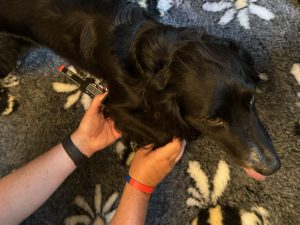 Last weekend we attended one of the largest Dog Agility shows in the UK, the Kennel Club International Agility Festival (KCIAF), where we met up with over 100 Cocker Spaniels. We were collecting data for research into Intervertebral Disc Disease (IVDD) as part of Bruno’s PhD. Continue reading
Last weekend we attended one of the largest Dog Agility shows in the UK, the Kennel Club International Agility Festival (KCIAF), where we met up with over 100 Cocker Spaniels. We were collecting data for research into Intervertebral Disc Disease (IVDD) as part of Bruno’s PhD. Continue reading
Mutation responsible for progressive retinal atrophy in the English Shepherd published
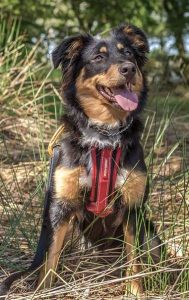 Back in March, CAGT launched a DNA test for progressive retinal atrophy (PRA) in the English Shepherd Dog breed (PRA6). Since then we have been working on a manuscript detailing our research and we are very pleased to announce that it was published last Sunday in Genes.
Back in March, CAGT launched a DNA test for progressive retinal atrophy (PRA) in the English Shepherd Dog breed (PRA6). Since then we have been working on a manuscript detailing our research and we are very pleased to announce that it was published last Sunday in Genes.
Stanbury K, Schofield EC, McLaughlin B, Forman OP, Mellersh CS. Exonic Short Interspersed Nuclear Element Insertion in FAM161A Is Associated with Autosomal Recessive Progressive Retinal Atrophy in the English Shepherd. Genes. 2024; 15(7):952. doi: 10.3390/genes15070952
Investigating the genetics of disc calcification in Dachshunds
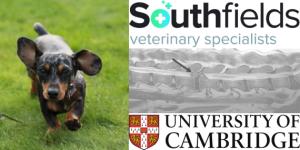 We have introduced Bruno Lopes to our supporters before – Bruno is a veterinary neurologist, from Southfields Veterinary Specialists, who has recently started studying for a PhD on a part-time basis at Cambridge Vet School. For his PhD, Bruno will be investigating the genetics of Intervertebral disc disease (IVDD), the most common cause of spinal injury in dogs. IVDD can affect all breeds but chondrodystrophic (short-legged) breeds are at highest risk and Dachshunds are more likely to be affected by IVDD than other breeds. Continue reading
We have introduced Bruno Lopes to our supporters before – Bruno is a veterinary neurologist, from Southfields Veterinary Specialists, who has recently started studying for a PhD on a part-time basis at Cambridge Vet School. For his PhD, Bruno will be investigating the genetics of Intervertebral disc disease (IVDD), the most common cause of spinal injury in dogs. IVDD can affect all breeds but chondrodystrophic (short-legged) breeds are at highest risk and Dachshunds are more likely to be affected by IVDD than other breeds. Continue reading
Five go to Finland Forum
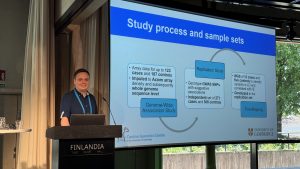 Last week five members of the Canine Genetics Centre (CGC) team visited Helsinki, Finland, to attend the 12th International Conference of Canine and Feline Genetics and Genomics (ICCFGG) – a trip made possible by a ring-fenced donation to the CGC. Continue reading
Last week five members of the Canine Genetics Centre (CGC) team visited Helsinki, Finland, to attend the 12th International Conference of Canine and Feline Genetics and Genomics (ICCFGG) – a trip made possible by a ring-fenced donation to the CGC. Continue reading
Epilepsy study sample collection off to a flying start
 Earlier this year the CGC announced the broadening of its idiopathic epilepsy (IE) project to include Beagles, English Springers, Giant Schnauzers, Hungarian Vizslas and Irish Setters. The IE team is pleased to report that the launch has met with a very enthusiastic response from dog owners: around 160 swab kits for the above five breeds have been sent out, with more kit requests coming in every day. Continue reading
Earlier this year the CGC announced the broadening of its idiopathic epilepsy (IE) project to include Beagles, English Springers, Giant Schnauzers, Hungarian Vizslas and Irish Setters. The IE team is pleased to report that the launch has met with a very enthusiastic response from dog owners: around 160 swab kits for the above five breeds have been sent out, with more kit requests coming in every day. Continue reading
A Focus on Eyes
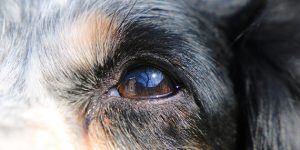 Last month we told you about an eye disease variant we recently identified in the English Shepherd Breed. Today we wanted to give you a bit more information on the research we do into inherited eye diseases (IED), all of which is now carried out under the CRIEDD (Consortium to Research Inherited Eye Diseases in Dogs ) project. Continue reading
Last month we told you about an eye disease variant we recently identified in the English Shepherd Breed. Today we wanted to give you a bit more information on the research we do into inherited eye diseases (IED), all of which is now carried out under the CRIEDD (Consortium to Research Inherited Eye Diseases in Dogs ) project. Continue reading
Canine Genetics Centre researchers collaborate with specialist veterinary neurologist to identify genetic cause of dog’s illness.
 Most of the researchers who work in the Canine Genetics Centre (CGC) are geneticists and we regularly collaborate with colleagues from the veterinary profession to ensure that we fully understand the diseases that we investigate, and that the dogs we include in our investigations have been robustly diagnosed. Continue reading
Most of the researchers who work in the Canine Genetics Centre (CGC) are geneticists and we regularly collaborate with colleagues from the veterinary profession to ensure that we fully understand the diseases that we investigate, and that the dogs we include in our investigations have been robustly diagnosed. Continue reading
Update on Primary Hyperparathyroidism in Keeshonds
 We are still trying to identify the genetic change that causes Primary Hyperparathyroidism (PHPT) in the Keeshond. It is proving to be much more challenging than initially anticipated, which may explain, at least in part, why the original research was never completed and published.
We are still trying to identify the genetic change that causes Primary Hyperparathyroidism (PHPT) in the Keeshond. It is proving to be much more challenging than initially anticipated, which may explain, at least in part, why the original research was never completed and published.
As part of the original Give a Dog a Genome project, we used short-read based Whole Genome Sequencing (WGS) to sequence a PHPT case and an epilepsy case (as a PHPT control). We have sequenced a further case and a progressive retinal atrophy (PRA) case as a control, giving us two cases and two controls. These data have enabled us to independently identify the chromosome that harbours the causative genetic mutation for PHPT, however we have been unable to precise variant.
We have recently been awarded a small grant from CamVet to undertake long-read sequencing of the candidate region in an attempt to identify additional variants. Preliminary data suggests that the region of interest is highly structurally complex and very difficult to interrogate, but sequencing and data analysis is ongoing.
Epilepsy programme update
 Alongside our current genetic investigations of idiopathic epilepsy in the Border Collie and Italian Spinone, we are embarking on an exciting new study starting this year to investigate the genetics of epilepsy in five new breeds – the Beagle, English Springer Spaniel, Giant Schnauzer, Hungarian Vizsla and Irish Setter. Continue reading
Alongside our current genetic investigations of idiopathic epilepsy in the Border Collie and Italian Spinone, we are embarking on an exciting new study starting this year to investigate the genetics of epilepsy in five new breeds – the Beagle, English Springer Spaniel, Giant Schnauzer, Hungarian Vizsla and Irish Setter. Continue reading

